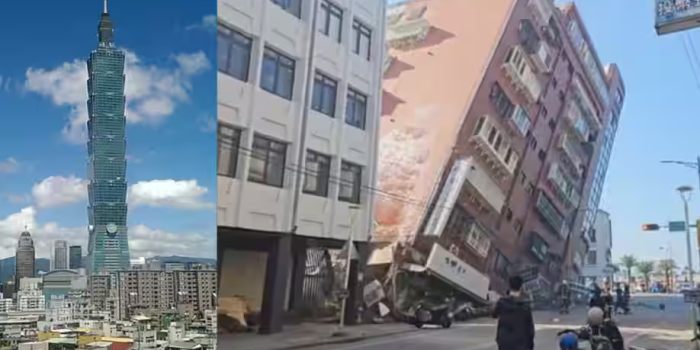In the northern parts of Taiwan, where a very strong earthquake occurred after 25 years, resulting in large numbers of fatalities with at least nine people killed, and large-scale destruction with buildings collapsing and even a tsunami warning issued. But in this abyss of destruction, an amazing spectacle occurred—the $1.8 billion Taipei 101 skyscraper, at one time the world’s tallest building, continued to stand strong, swaying gently like a reed in the wind.
The mystery of Taipei 101 being capable of surviving such huge and high forces is solved by advanced engineering designs. This tower stands 1667 feet, or 508m, high, and the impact of the earthquake was diminished by a neat technological solution that achieves a swing reduction rate of about 40% for earthquakes and high wind speeds. On the inside of the tower, an impressive 660 metric ton golden sphere that goes by the name “tuned mass damper”, can be spotted hanging from the ninety-second floor.

Image courtesy: Mail Online
The tuned mass damper works on a straightforward but efficient premise. The steel sphere moves in the opposite direction of the building’s swaying in response to outside influences, counteracting the movement and preserving the stability of the structure. This passive dampening device operates just on gravity and the motion of the building; it doesn’t need any external power.
Beneath the sphere, there are hydraulic pistons that further absorb and dissipate energy, avoiding excessive movement and guaranteeing the safety of the building. Expert in structural dynamics Dr. Agathoklis Giaralis compared the damper to a pendulum to emphasize how it reduces the swing between the sphere and the structure.
Contemporary skyscrapers are made to be adaptable, especially those in earthquake-prone areas like Taiwan. Because of the elastic materials used in their manufacture, they can expand or contract in reaction to outside influences. Although these vibrations do not harm the structure itself, residents may find them uncomfortable if they occur too frequently.

Commencing in 1999, Taipei 101’s construction was finished in time for New Year’s Eve 2004, signifying Taiwan’s tenacity and dedication to innovation. Eight pieces piled like square buckets give the skyscraper’s design, which resembles a bamboo stalk, structural stability.
Taiwan’s proactive response to earthquake preparedness, which includes strict building rules, a strong seismological network, and public education campaigns, illustrates its commitment to safety despite the horrific toll of the earthquake. The world observes with admiration as Taiwan continues its recovery efforts, while Taipei 101 stands as a tribute to human resourcefulness in the face of nature’s fury.


